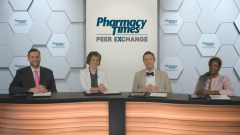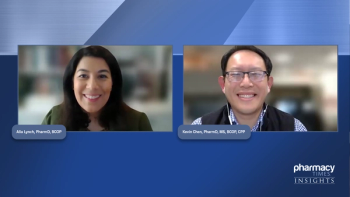
Examining the Incubation Period of RSV
The panel explores RSV infection susceptibility and transmission.
Episodes in this series

Ryan Haumschild, PharmD, MS, MBA: When we’re contextualizing the discussion of RSV [respiratory syncytial virus], the question that always comes up if this something I need to look at seasonally. Is it year-round? When should I look at it? And how often should I communicate that with our patients? Ms Bridgeman, maybe you can help answer that question. Is it something seasonal? Is it year-round? Has the season changed in recent years?
Mary Bridgeman, PharmD, BCPS, BCGP, FASCP: In most regions of the United States and countries with comparable climates, there’s an RSV season. Activity seems to increase or start in the fall and peak in the winter months, and it may persist into the springtime. Interestingly, Florida and Hawaii and some warmer-climate areas may have an earlier RSV season compared with other areas, and a season that persists longer than in other regions of the country. There’s absolutely a regional consideration for RSV.
Christina Madison, PharmD, FCCP, AAHIVP: Right now we’re in an interesting time frame. As you can see, we saw a much earlier onset of the season because we had universal masking and individuals were not congregating. We did see a bit of an earlier onset of the season. It seemed to be year-round vs the traditional pattern prior to the pandemic. I just wanted to point that out. We’re in a unique standpoint because we had universal masking for 2 years. Now all of a sudden, we have these viruses that are like, “Look, we have somewhere to go.”
Mary Bridgeman, PharmD, BCPS, BCGP, FASCP: I want to piggyback [on that] excellent point. The CDC [Centers for Disease Control and Prevention] has some fantastic and fascinating data. You can look at all the RSV epidemiological evidence that exists. The CDC website is a great resource, with surveillance data surrounding RSV monitoring for each season. There have been shifts in the predictability of this virus. Although I described the classic presentation or timeline, that’s changed since 2020. Some predictability has gone a little awry in the southern United States. RSV activity began to rise in spring 2021. It peaked in July, which was almost unheard of and certainly atypical for an RSV season. The CDC tells us it’s too soon to tell because of the precautions that we’ve implemented over the past 3 years. It’s too soon to know if these shifts are likely to be permanent or if we’ll get back to that traditional pattern as our precautions lighten.
Adam C. Welch, PharmD, MBA, FAPhA: Who would have thought that covering your cough for COVID-19 would help decrease influenza and RSV and transmission as well?
Mary Bridgeman, PharmD, BCPS, BCGP, FASCP: Absolutely.
Christina Madison, PharmD, FCCP, AAHIVP: I did.
Ryan Haumschild, PharmD, MS, MBA: With mask mandates having gone away, it will be interesting what it’s like with our natural immune system getting exposed to these. What does the incubation period look like, and how should we be aware? Is someone asymptomatic? Mr Welch, can you touch on that a little? When we think about the incubation period, how does that relate to RSV? Can carriers be asymptomatic, and should we be aware of that?
Adam C. Welch, PharmD, MBA, FAPhA: When someone is asymptomatic, they don’t think they’re sick. They’re not taking the same precautions they would if they are physically ill and have the runny nose and the sneezing and coughing and all the symptoms that we’ve described. With RSV, the contagious period is about 3 to 8 days. The problem is that you can transmit RSV to someone else a day or 2 before you even notice symptoms. Individuals are transmitting it, then they come down with the symptoms and feel ill, but they’ve already transmitted to someone else. That cycle repeats. This can happen with children who bring home RSV from day care or infants and grandparents who kiss them or touch the bed railings. The virus itself can remain virulent on surfaces for several hours. You might not even be exposed to someone, but you touch a surface and then touch your face without washing your hands. Transmission is still a problem because we don’t know if we’re contagious.
Mary Bridgeman, PharmD, BCPS, BCGP, FASCP: Transmission via droplets—that’s a key piece.
Adam C. Welch, PharmD, MBA, FAPhA: Respiratory droplets.
Mary Bridgeman, PharmD, BCPS, BCGP, FASCP: Droplets from someone infected with the virus.
Christina Madison, PharmD, FCCP, AAHIVP: I love that you brought up the unfortunate scenario where a child brings home an infection to their mom, dad, grandfather, uncle, or someone immunosuppressed in the household. Because of that, we’ve been very vigilant about bringing that up and making sure anyone who’s in an immunocompromised household knows that even if someone else in the house doesn’t want to mask, masking is something that can protect your against those pesky droplets.
Ryan Haumschild, PharmD, MS, MBA: When we think about those droplets, and someone becomes symptomatic and passes it on to someone older or younger, there’s a period where they’re contagious. Mr Welch, how long are they contagious? Does it change if someone is immunocompromised vs not immunocompromised when we’re thinking about the life cycle of the virus within the body?
Adam C. Welch, PharmD, MBA, FAPhA: The contagious window is 3 to 8 days for someone with normal immune function. But if you’re immunosuppressed, you could be contagious for several weeks, even up to a month. They may be spreading this virus to other individuals because their own body is having a tougher time controlling the virus, and they can become contagious and continue to spread it.
Ryan Haumschild, PharmD, MS, MBA: Mr Welch, you talked about patients who are immunocompromised. Earlier we mentioned comorbidities. I’d like to delve into that a little deeper because nowadays we have patients who are living longer and older adults who might be more susceptible. A lot of our patients have comorbidities. A lot of them might be cardiac in nature, dealing with heart failure and things like that. Ms Madison, do certain comorbidities predispose patients to more severe infections? You touched on it a little, but what are those specifically, and how should we deal with those patients a little differently?
Christina Madison, PharmD, FCCP, AAHIVP: Anyone who works in pulmonary health, anyone who’s a gerontologist, all those individuals should be thinking about RSV. We talk about it with cardiology colleagues as well because of the high risk due to cardiovascular disease, specifically heart failure. Another thing I want to point out is that we don’t talk a lot about historically marginalized populations like the LGTBQ community. One of the health disparities is that they’re more likely to smoke, have problems with being unhoused, have issues with substance use. I want to make sure that I bring that up because we see different risks. Individuals may be inhaling, injecting, and using intranasal drugs, which would potentially put them at risk for RSV, [along with those in] high-congregate settings and individuals who are around younger children. All those things combined put individuals at a higher risk for acute infection.
For older adults in particular, make sure they’re going in for annual checkups. They’re not just picking up just their routine prescriptions but having an in-person visit in between. Yes, telehealth is fine, but there’s a lot to be said about seeing patients in person. You can physically see them, see if they have labored breathing, see if they’re pink. You can’t see that on a video screen. You need to see patients in person to see if they’re having labored breathing. Are they having difficulty walking up steps? We should be asking those questions because they could put them at risk for this respiratory illness.
Ryan Haumschild, PharmD, MS, MBA: I love the diagnostic work-up. In the spirit of diversity, equity, and inclusion, we need to look at social determinants of health, where patients are coming from, and if they’re even able to travel. If they are, can we capture them at 1 period of time and do a more holistic work-up to make sure we’re providing the right therapeutic recommendations? Those are great points. Thanks for reviewing.
Christina Madison, PharmD, FCCP, AAHIVP: It’s important to think about meeting patients where they are. During the pandemic, most individuals, especially adults, were within 5 miles of a pharmacy. That could be the difference between them having to walk or take public transportation. That puts them at risk because if they’re taking public transportation, that’s a high-congregate setting—planes, trains, automobiles, all those things. If you don’t have your own car, that puts you at a higher risk of getting another communicable illness.
Transcript edited for clarity.
Newsletter
Stay informed on drug updates, treatment guidelines, and pharmacy practice trends—subscribe to Pharmacy Times for weekly clinical insights.



